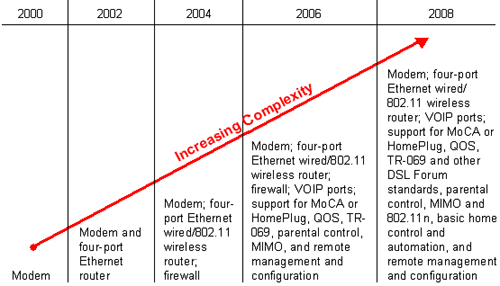RBOCs Want Inside Your House
US RBOCs see home networking and device management as a big part of their broadband plans

As if selling you voice, video, and data services weren't enough, three of the nation's largest phone companies have designs to help build and manage your home network, too.
In recent interviews with three RBOC technology executives, AT&T Inc. (NYSE: T), Verizon Communications Inc. (NYSE: VZ), and Qwest Communications International Inc. (NYSE: Q)each told Light Reading that being a service provider will soon mean managing all aspects and equipment related to any voice, video, and data service inside the home. (See IP Video: In the House.)
Each provider has a slightly different take on what type of residential gateway to use, and the video distribution schemes are still coming into focus. But it is clear that residential gateways are increasing in importance, as are the ability of carriers to hold on to customers for life by managing all the services that touch their homes. More importantly, though, this push into home networking now -- and, later, device management -- could be a key to the RBOC's survival. As Heavy Reading's Graham Finnie wrote in his February report, carriers allowed themselves to be thought of as "dumb pipe" providers by not taking more control of telephone management and, later, broadband devices. (See The DSL Gateway Dilemma.)
More importantly, though, this push into home networking now -- and, later, device management -- could be a key to the RBOC's survival. As Heavy Reading's Graham Finnie wrote in his February report, carriers allowed themselves to be thought of as "dumb pipe" providers by not taking more control of telephone management and, later, broadband devices. (See The DSL Gateway Dilemma.)
"This encouraged a sense among consumers that telcos were just pipe providers; so by becoming again the major supplier of more sophisticated (and subsidized) home equipment, service providers could reclaim the initiative on new broadband services." Finnie writes. He points out in the report that, according to one service provider, "The raw-pipe threat has never been as big as it is today, so we must be more present in devices."
Indeed, the major CTOs of the large U.S. RBOCs apparently agree with this statement, and they are looking at broadband as a launching point into more managed home services.
"The service provider can offer the managed solution to them to handle the firewall, manage the anti-spam and the anti-spyware programs, and ensure that there is the adequate priority of services inside the home," says Chris Rice, AT&T's executive VP of network planning and engineering.
Rice says AT&T is using TR-069, a management protocol drafted by the DSL Forum, along with 2Wire Inc. 's residential gateway, to manage consumer home networks for Lightspeed customers. "Much like businesses prefer to use managed services, we think consumers will look for managed services, too," he says.
Verizon is also making its way inside consumer homes. "We have this center piece of our home networking architecture called the broadband home router (BHR) and we’re providing IP connectivity from the network to the BHR and then...adding NAT functions, network address translators, to all the devices that sit behind them, whether they be for data or they be for video or even conceivably for voice," says Verizon CTO Mark Wegleitner .
He adds that the broadband home router "really exists today" and it has "all the things you would expect to find in a home router, plus MoCA."
Multimedia over Coax Alliance (MoCA) is a group formed to promote standards for home networking equipment using coaxial cable.)
Table 1: Residential Gateways In The Digital Home
EQUIPMENT | RELATIONSHIP TO GATEWAY |
Modem | Usually integrated |
Router | Usually integrated |
Wireless Network | 802.11, usually integrated |
Wired Network | Ethernet usually integrated, other wired home networks becoming integrated |
Analog POTS or ISDN Phone | Analog terminal adapters increasingly integrated |
VOIP Phone | Usually via phone port only; small number of vendors include phone cradle |
DECT Phone | Some vendors support DECT via gateway |
Mobile (Dual-Mode) Phone | Rapidly increasing interest in support |
Desktop/Laptop PC | Directly connected |
Media Center/Server/Storage | Not integrated, but increasingly connected; seen as playing a key role in content distribution |
IP STB | Not usually integrated, but increasingly connected and quality-controlled via gateway; some see more integration in the future |
TV | Usually connected via separate STB, not gateway |
Personal Video Recorder | Usually connected to TV; seen by some on consumer electronics side as playing an important role in content distribution |
Game Console | Increasingly connected directly; some vendors have games-oriented gateways |
Dedicated Home Control & Automation Equipment | Not connected, rarely based on IP; some vendors and service providers looking at bridging devices to connect |
Video Monitoring and Related Security Equipment | Beginning to be connected; some interest, especially in certain countries |
HVAC and Domestic Appliances | Not usually connected; some interest, especially in certain countries |
Source: Heavy Reading |
In fact, according to Verizon's Executive Director of Access Terchnologies, Brian Whitton, the BHR will have two chipsets based on the MoCA technology standard inside. This allows Verizon to (1) get broadband data and video from outside the home to the BHR and (2) move broadband data and video between the BHR and other devices via existing coaxial cable. Essentially, it creates a WAN and LAN in the home using just one physical set of cables to connect the optical network terminal (ONT) outside the home to the BHR to the MoCA-enabled set-top box on the TV.
Continue to page 2
Whitton says it will announce its vendor pick soon. But its worth noting that Westell Technologies Inc. (Nasdaq: WSTL) is one of the only vendors that has made noise about being able to make a home gateway with two integrated MoCA chipsets. The company is already a Verizon supplier; it makes Verizon One handset -- a phone that integrates a DSL modem, a 802.11g wireless router, a 5.8 GHz cordless phone, and a color-touch screen.
According to Wegleitner, Verizon will be able to manage and configure the BHR via TR-069, and, when more standards work is done, the carrier can "extend management to other devices...so that we can really have a picture of what’s going on in the household help the consumer configure and manage what they’ve got," Wegleitner says.
"What we're trying to do is make sure the user has a pleasant experience...and we’re trying to cut down our costs because every time we dispatch a truck, it costs $125 just to get a truck to the customer's front door," Wegleitner says.
Other services could come conceivably come into play later on, such as having the carrier monitor home security systems -- and allowing customers to check on their homes via Internet-connected computers and other devices. But analysts say those services are unlikely in the near term. Right away, carriers really just want to evolve to manage the customer's experience, according to Heavy Reading analyst Rick Thompson.
"Once a provider starts sending voice, video, and data into the home, it will need to prioritize that home's network traffic so that simple user requests such as IPTV channel changes aren't stuck in a queue behind less time-sensitive items, such as email," Thompson says.
Qwest wasn't as forthcoming as its peers, but definitely lit up at the chance to talk home networking. "We are planning to do something in the DSL space, I don’t want to give specifics on that," says Qwest CTO Pieter Poll. "What I will say is we already, by default offer, wireless networking capabilities in all our DSL modems, right out of the box."
Likewise, Poll cautions that any move into home networking by a service provider, also assumes the mantle of providing security, network configuration instructions, and some smart way of handling video distribution within the home. "We’re on the page of using existing telephony wiring but using things like HPNA and other technologies that would allow video distribution."
That wisdom comes from experience, Poll says. In the 90s, when Qwest first deployed video services via VDSL, it installed CAT5 wiring inside consumer homes to allow for video distribution. Poll says what followed were horror stories of summers in Texas and Phoenix where it was 100+ degrees outside and installations were taking one and a half days. "We were learning and I think everyone’s going to learn that as we go into the video environment," he says. (See Qwest Building FTTP Network and RBOC IPTV: The Quiet Ones.)
— Phil Harvey, News Editor, Light Reading
Read more about:
OmdiaAbout the Author(s)
You May Also Like












